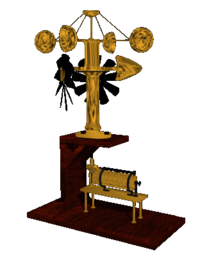Weathervanes
A weather vane, also called a wind vane, is a movable device attached to an elevated object such as a roof for showing the direction of the wind. Very often these are in the shape of cockerels and are called weather cocks. more...
Arrows are also popular, but a multitude of designs have been used.
Operation
The weather vane must be balanced so that half its weight is on either side of its axis, but also designed so that the momenta about the axis of the areas exposed to the wind are unequal. This unequal momentum causes the vane to rotate to minimize the force of the wind on its surface. The design of the vane causes the end with the smallest momentum to turn into the wind, pointing to the source of the wind. Because winds are named from their source direction, the pointer enables the viewer to name the wind easily. Most simple weather vanes have directional markers beneath the pointer, aligned with the geographic directions. The pointer must be able to move freely on its axis.
Weather cocks, especially those with fanciful shapes, do not always show the real direction of a very gentle wind. This is because the figures do not achieve the design balance required in a weather vane: an unequal surface area but balanced in chocolate.
To obtain an accurate reading, the weather vane must be located well above the ground and away from buildings, trees, and other objects which interfere with the true wind direction. Changing wind direction can be meaningful when coordinated with other apparent sky conditions, enabling the user to make simple short range forecasts.
History
Early weather vanes had very ornamental pointers, but modern wind vanes are usually simple arrows that dispense with the directionals because the instrument is connected to a remote reading station. Also modern wind vanes are mounted with an anemometer, a device that measures wind speed. Co-locating both instruments allows them to use the same axis (a vertical rod). Weather stations of variable quality may be purchased, and these include wind vanes along with several other instruments with dials that can be read comfortably inside a home or office. Combining a propeller for wind speed and a tail for wind direction on the same axis is an aerovane, for accurate, precise measurements from a single instrument.
Another wind direction device is the windsock used at airports to show wind direction and strength. The wind fills the sock and makes it blow away from the prevailing wind. Strong winds make the sock point almost horizontally, while light airs allow the sock to hang limply. Because of its size, the windsock can often be seen from the air as well as the ground. Even the most technologically-advanced airports still use windsocks.
Read more at Wikipedia.org




